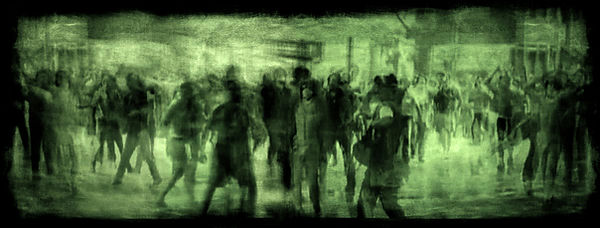RITMOS PRIMARIOS
VIDEO - PHOTOGRAPH

SOULEVEMENT_ JEU DE PAUME, PARIS, FRANCIA 2016





Writing with light
There is a labor of encryption here, and though it may be invisible, it is nevertheless responsible for the effect that captivates us as viewers. This task identifies several stages during which time is de- constructed in order to be reconstructed. The manipulation leaves signs, enabling us to follow its tracks, tracing it back to its inten- tions or at least to see how the effect is achieved.
Let us look at the process in reverse, the best approach when it comes to chasing down the past, which the artist seems to have been determined to do for quite some time, no holds barred and without the least bit of naïveté: Aveta does not think that the timeline is a line at all. Nor does he think that time is counted progressively.
Let us consider the film: 8 morose, delayed minutes, the result of editing that refuses customary cut and paste logic which blocks out lapses and smoothes over rough spots, erasing discontinuities. Here, he makes them appear. He fabricates the gaps instead of cov- ering them. Everything is an unreal green; everything looks as if we had put on special glasses in order to see in the dark. That’s just what it is: this work, like many others by the artist, are ways of see- ing in the dark.
There are jumps in the editing; at twenty frames per second, single frames can be perceived to reverberate, producing echoes that Aveta meticulously registers, like examining time via sono- gram. These are images that come from the past headed into the future, or that go from the future into the past. In these images State violence never ends, as never-ending as the pain of its vic- tims.
The background has a linen texture and the projector is a ma- chine that paints images on the canvas; the artist paints with film frames. The light that the artist works with, however, is not from this galaxy: the light that this series captures comes from far away, from stars long dead. In the course of its thousand-year journey, that light has become the truest of all for relating disappearance.
The canvas really existed. It was mounted on a stretcher that the artist then covered with a special emulsion, paint that is not
used to cover, but to portray what is no longer present. He pro- jected every single frame of the film onto that stretcher, one after the other.
If you were to assign every artist one single material with which to say what he or she has to say, the one Aveta would settle on would be that phosphorescent paint, designed to capture what dis- appears without denying—as any photograph does—death.
Each of the projected photographs slowly fades, the emulsion- coated canvas just barely capturing its aura. At this moment an- other is projected, then another and another. As a result, what time arranges diachronically co-exists simultaneously in space, albeit not in full-fledged materiality but in a state more closely related to human matter: that of disappearing.
Aveta’s work is situated at the extreme opposite of a photo- graphic laboratory, where the secret pleasure of the images’ pro- gressive appearance on the paper belongs to the person doing the developing. Here it is just the opposite: disappearance is portrayed. It is capturing the precise moment—fleeting by definition—when things cease to be.
The specter-populated canvas is photographed, and each one of these photographs is arranged again diachronically. In showing this, some bit of what cannot be captured, what is always left over and cannot be said remains ensnared within that alchemy.
The result has a beauty that is surreal and somber. Viewers do not know that it is about absence and yet they do know. Their bod- ies know. Explaining the process fulfills that function, in any case: it explains to the mind what the body already knows.
Mariano Horenstein